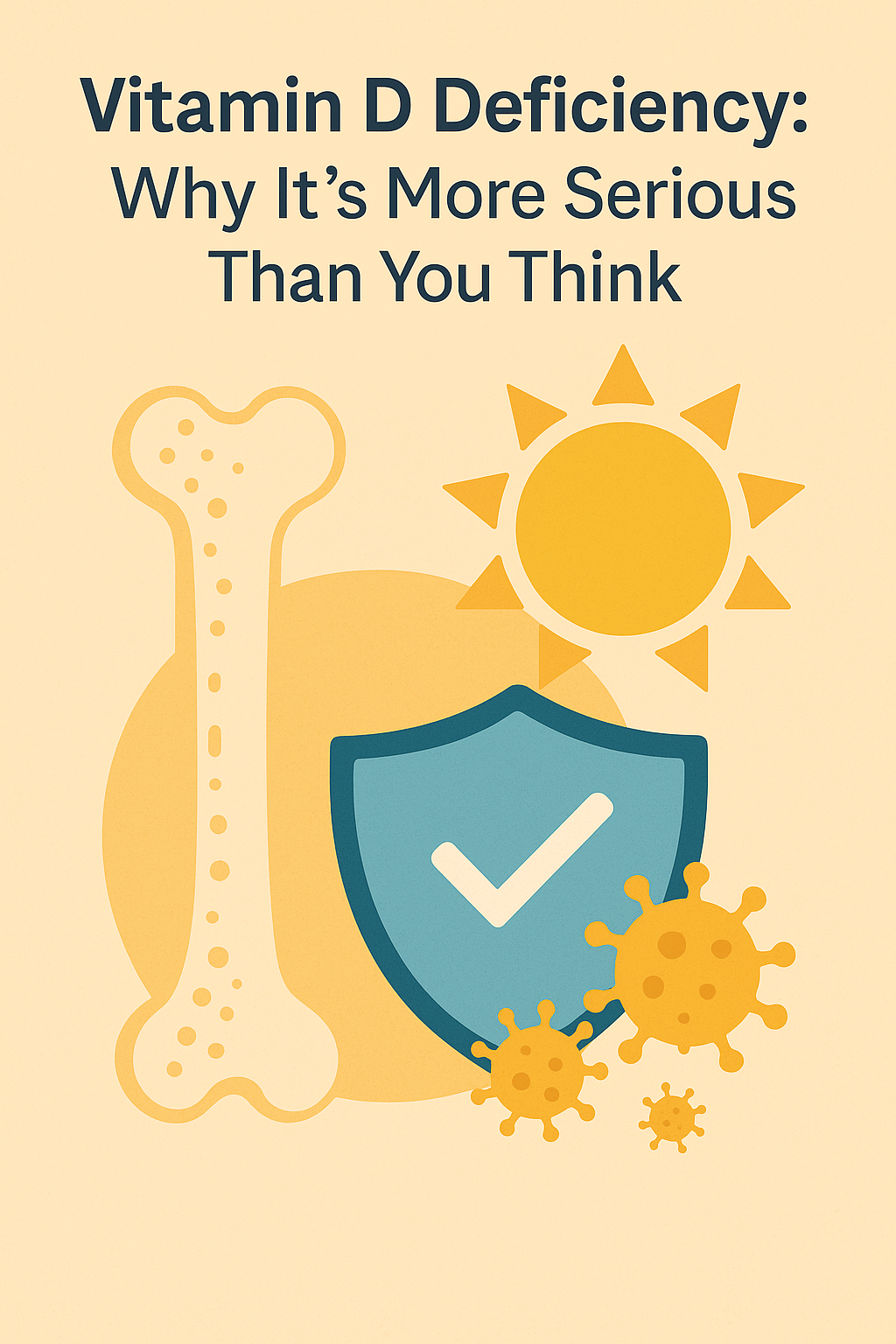Vitamin D Deficiency: Why It’s More Serious Than You Think


Introduction
Vitamin D is not just a “bone vitamin.” It is a vital hormone-like substance influencing bones, muscles, the immune system, cardiovascular health, and even mental well-being. Deficiency is often silent, creeping in unnoticed, but its long-term consequences can be profound. As physicians, we encounter this problem daily in practice, yet it remains underestimated by patients and even some professionals.
General Readers
For the general public, vitamin D deficiency is more common than most people realize. Despite abundant sunlight in many regions, modern lifestyles—indoor work, limited outdoor exposure, and sunscreen use—have led to widespread low levels. Symptoms may include tiredness, vague muscle aches, back pain, low mood, frequent infections, and poor sleep. Left untreated, it can weaken bones (osteoporosis, fractures), impair immunity, and even increase risks of diabetes, heart disease, and depression.
Simple blood testing can confirm the deficiency, and treatment usually involves oral supplementation and safe sunlight exposure. Diet alone is rarely enough, as only a few foods naturally contain vitamin D.
Medical Students
For medical students, it is important to remember that vitamin D acts more like a prohormone than a vitamin. Its biologically active form—calcitriol (1,25-dihydroxyvitamin D3)—binds to nuclear receptors influencing gene transcription across multiple organ systems. Pathophysiology of deficiency involves inadequate cutaneous synthesis, low dietary intake, malabsorption syndromes, chronic kidney disease (impaired hydroxylation), and certain medications (e.g., anticonvulsants).
Clinically, deficiency manifests as rickets in children and osteomalacia in adults. But beyond musculoskeletal consequences, studies highlight links to autoimmune disorders, metabolic syndrome, tuberculosis susceptibility, and even some cancers. Students must learn to integrate vitamin D into systemic thinking rather than viewing it solely as a “bone health” nutrient.
Young Doctors
For junior doctors, the practical approach involves recognition, investigation, and correction. Common presentations include vague pain syndromes, fatigue, proximal muscle weakness, and non-specific depression. Always consider vitamin D deficiency in patients with repeated fractures, delayed healing, or unexplained musculoskeletal complaints.
Investigations:
• Serum 25-hydroxy vitamin D (best marker)
• Calcium, phosphate, ALP (to assess bone turnover)
• PTH (if secondary hyperparathyroidism suspected)
Treatment guidelines vary by region, but typically:
• Mild deficiency: 1,000–2,000 IU daily
• Moderate to severe deficiency: high-dose weekly/monthly regimens followed by maintenance
• Always combine with calcium if dietary intake is low
Emphasize monitoring, especially in elderly, renal disease, and patients on long-term steroids.
General Practitioners
For family physicians and general practitioners, vitamin D deficiency is both a diagnostic challenge and a preventive opportunity. Patients often present with nonspecific symptoms that could mimic fibromyalgia, chronic fatigue syndrome, or early arthritis. Testing is simple, yet underutilized.
GPs must balance population-level prevention (encouraging sunlight, dietary fortification, lifestyle advice) with individualized supplementation strategies. Screening high-risk groups—elderly, postmenopausal women, patients with chronic illnesses, and those with limited sun exposure—is crucial. Moreover, vitamin D correction has far-reaching preventive potential, reducing risks of falls, fractures, infections, and possibly cardiovascular events.
When to See the Doctor
• Persistent fatigue, body aches, or unexplained weakness
• Frequent respiratory infections or poor wound healing
• Children with delayed growth or skeletal deformities
• Elderly with recurrent falls or fractures
• Patients with chronic diseases (renal, liver, malabsorption)
• Anyone with documented deficiency despite lifestyle modification
Conclusion
Vitamin D deficiency is not a trivial matter. It is a global health problem with silent but serious consequences. Recognizing and treating it early can prevent years of morbidity and improve quality of life. As physicians, our responsibility lies not only in prescribing supplements but also in educating, screening, and preventing. For the public, the message is clear: do not ignore fatigue, weakness, or bone pain—sometimes, the problem is as simple, and as serious, as vitamin D deficiency.
